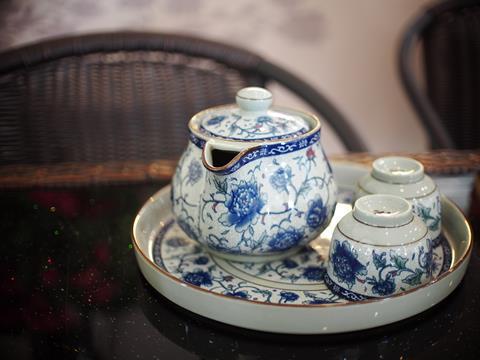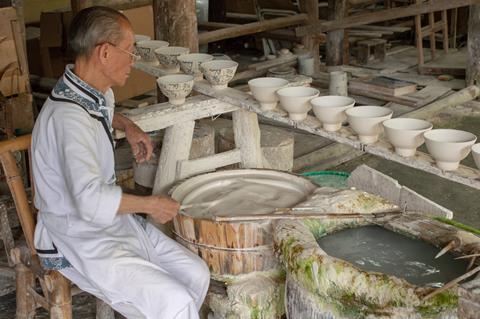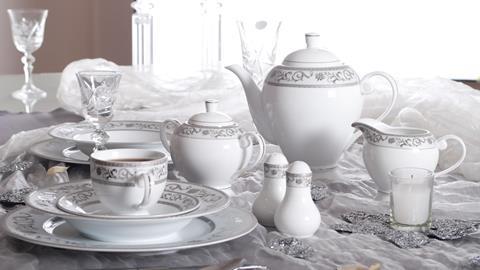Ben Valsler
This week we’ll get out the posh china, as Mike Freemantle examines porcelain. Once again the coronavirus crisis prevents me from meeting up with Mike, so I’ll be reading his words.
Michael Freemantle
Sitting in front of my computer screen, I looked vacantly out of the window at the rain and wondered how to start this podcast. Should I begin with a quote I had noted down about Rosa Dartle, a character in the novel David Copperfield by English writer Charles Dickens?
‘… a hand so thin and delicate, that when I had seen her hold it up before the fire to shade her face, I had compared it in my thoughts to fine porcelain.’
Or perhaps I should start with the history of porcelain – how the Chinese slowly acquired the skills and knowledge to produce it over thousands of years. The earliest recorded specimens date back to the Tang dynasty which lasted from 618 to 907 AD.

My attention then turned to a mug on my desk. I don’t use it for drinking tea or coffee. It is filled with ballpoint pens. More importantly, the outside of the mug features a colourful version of the periodic table of elements. The mug is made of bone china. When I removed the pens and held it up to the light, I could clearly see the outline and colours of the periodic table from the inside of the mug. Translucency is one of the attractive and characteristic properties of bone china.
China with a small ‘c’ is another name for porcelain. The first porcelains in Europe were produced at the Meissen factory near Dresden in January 1710. The secret of making these porcelains using natural clays and powdered rocks similar to those used by the Chinese was uncovered in a laboratory in Dresden by its chief chemist Walther von Tschirnhaus and the alchemist Johann Böttger.
Nowadays, porcelain is used not only by potters but also for making a wide variety of products, for example bathroom tiles, laboratory equipment such as Büchner funnels, and electrical insulators for high power transmission.

‘All “true” porcelains are compounded practically from two ingredients, kaolin and felspar (sic), with a small proportion of silica in the form of quartz or sand, but the materials used by potters in their body-mixtures differ widely in different countries.’
So wrote English chemist William Burton in his book Porcelain: Its Nature, Art and Manufacture, published in 1906. Burton worked for the Wedgwood Company in Stoke-on-Trent, an English town renowned for its potteries.
Kaolin is also known as china clay. The material is rich in kaolinite, a layered silicate mineral. Each layer consists of a sheet of silicate tetrahedra and a sheet of aluminate octahedra attached to hydroxide ions. The layers are held together by hydrogen bonds. Feldspars, as Brian Clegg explained in last week’s podcast, are aluminosilicate minerals that constitute the most abundant group of minerals in the Earth’s crust.
Feldspathic porcelains are prepared by mixing the ingredients with water to form a clay or ‘body’ as it is known by potters. The body is then shaped into the desired object and slowly heated in a kiln to temperatures up to 1400oC. The high temperature vitrifies the material making it non-porous and glassy. The vitreous material contains needle-like crystals of mullite, a heat-resistant aluminosilicate mineral that contributes to the mechanical strength of porcelain.
Burton noted in his book that feldspathic porcelains are, in his words, ‘distinguished by their whiteness, hardness, and complete vitrification. … The body is so hard that it cannot be scratched by a steel tool; it is impervious to staining fluids in the ordinary way.’

In 1749, the Anglo-Irish artist Thomas Frye, who was a proprietor of the Bow porcelain factory in London, was granted a patent for using bone ash in porcelain manufacture. The English potter Josiah Spode, who established a pottery works in Stoke-on-Trent in 1770, subsequently improved Frye’s formulation and developed the process for making what became known as English bone china.
Bone china is produced from a mixture typically containing up to 50% bone ash as well as kaolin and feldspar. The ash is prepared by heating crushed animal bones to a high temperature. It contains a high level of tricalcium phosphate which contributes to the translucency of bone china.
‘How the English potter ever came to add such a material … will never be known,’ Burton observed. What is clear, however, is that the development and production of porcelain in the 18th century became a European obsession that has continued to this day. My periodic table mug is evidence of that.
Ben Valsler
Those were the words of Mike Freemantle on porcelain, and coincidentally I have exactly the same periodic table mug. We’ve got another newsworthy compound next time, as Oxford University released results from a Covid-19 clinical trial this week, showing that steroid drug dexamethasone reduced mortality in some coronavirus patients. I’ll explore the history of the drug, and – in the absence of a peer-reviewed publication – take a look at these recent results.
Until then, find all of our previous podcasts at chemistryworld.com/podcasts, and get in touch in the usual ways: email chemistryworld@rsc.org or tweet @chemistryworld. I’m Ben Valsler, thank you for joining me.
Additional information
Theme: Opifex by Isaac Joel, via Soundstripe
Additional music: Sonata Romantique in G major by Wild Wonder, via Soundstripe













No comments yet